|
|
Post by duwayne on Mar 8, 2023 19:52:00 GMT
The big question for me with respect to ENSO is why do the trade wind velocities change so much when the basic driver, the earth’s rotation (Coriolis effect) doesn’t change? It’s clear these unpredictable (so far) westerly windspeed changes (SOI) drive ENSO.
What drives the SOI? |
|
|
|
Post by missouriboy on Mar 8, 2023 21:43:17 GMT
The big question for me with respect to ENSO is why do the trade wind velocities change so much when the basic driver, the earth’s rotation (Coriolis effect) doesn’t change? It’s clear these unpredictable (so far) westerly windspeed changes (SOI) drive ENSO. What drives the SOI? I found these Tradewinds data a couple of days ago. When I plot them with solar cycles ... seems clear that the trades have two peaks. They die down as the solar cycle resets, then kick off to solar maximum, follow the solar cycle downward, then rise again in the last part of the cycle. The Trade Index is for the Western Pacific. When you plot the Nino 4 Index against the Trade Index, you note that Nino 4 temperatures rise as the Trades die down. Not a scientific explanation. Just observations.
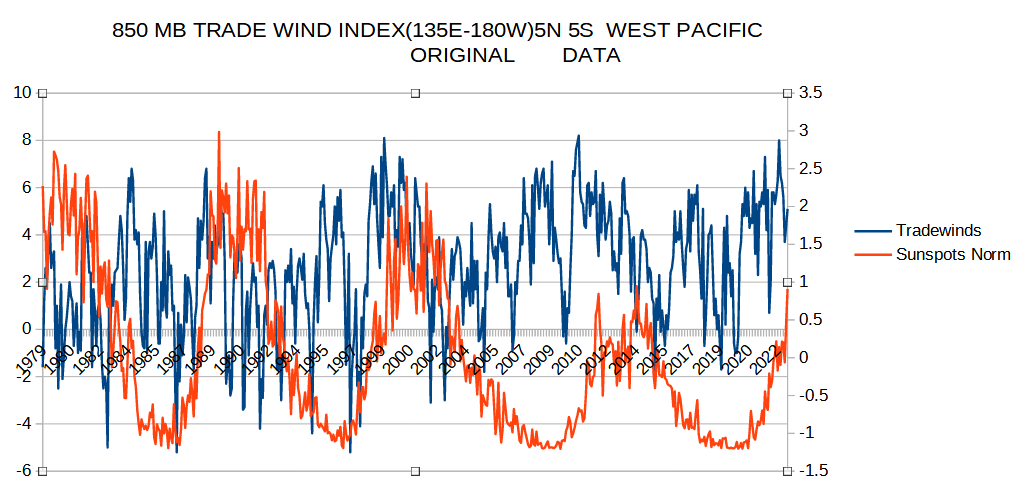 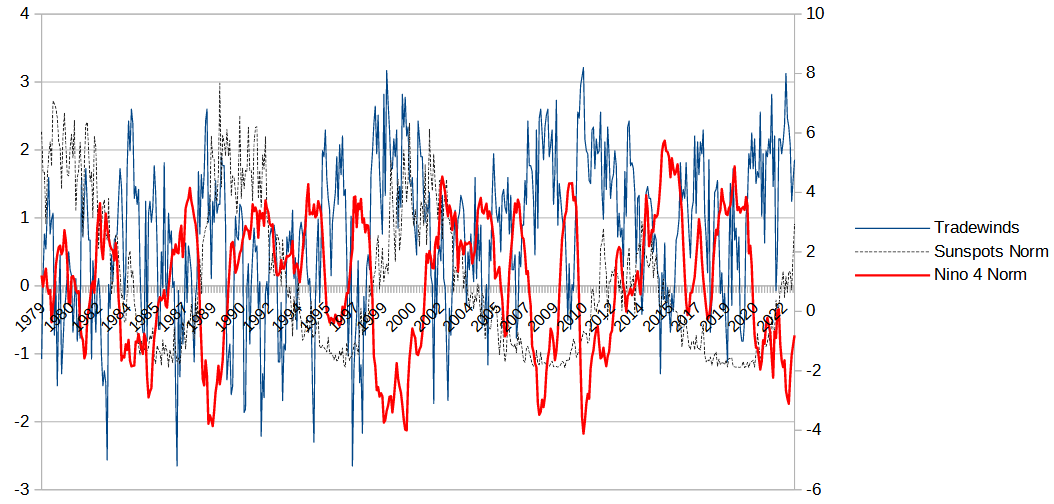 |
|
|
|
Post by duwayne on Mar 9, 2023 18:34:33 GMT
The big question for me with respect to ENSO is why do the trade wind velocities change so much when the basic driver, the earth’s rotation (Coriolis effect) doesn’t change? It’s clear these unpredictable (so far) westerly windspeed changes (SOI) drive ENSO. What drives the SOI? I found these Tradewinds data a couple of days ago. When I plot them with solar cycles ... seems clear that the trades have two peaks. They die down as the solar cycle resets, then kick off to solar maximum, follow the solar cycle downward, then rise again in the last part of the cycle. The Trade Index is for the Western Pacific. When you plot the Nino 4 Index against the Trade Index, you note that Nino 4 temperatures rise as the Trades die down. Not a scientific explanation. Just observations.
  You probaly already knew this but the logical explanation for why the surface warms as trade winds slow is there is less upwelling and less of the cool subsurface water being pumped to the surface along the South American coast. In addition warmer western water sloshes back from the west to the east. It had been stacked to the west at least on a relative basis by the stronger western winds.
We are left with the question of why the wind changes.
|
|
|
|
Post by duwayne on Mar 9, 2023 22:13:10 GMT
I've taken the liberty to copy my Weekly BOM ENSO3.4 Progression Chart, NOAA's recent prediction, Missouriboy's recent prediction and my recent prediction below. Hopefully Ratty will think to pull this back up in a year. Missouriboy's and my prediction's are very similar, if not the same. The NOAA is in a different world. I'll have to admit I'm not as confident about my ENSO prediction as I am in my UAH temperature prediction. I'd still like to have a better basis for predicting the prevailing westerly winds. Missouriboy has talked me into following the solar cycle to some degree since he was right on the Current La Nina, but I'm pretty fickle.
(Missouriboy, if you don't feel comfortable with my copying your prediction here, let me know and I'll delete it. But that opportunity to erase is not open-ended.)
Missouriboy's Prediction copied from his recent post:
"I have come to the conclusion that there are at least two distinct types of El Ninos ... (1) those that precede the sunspot "kickoff" in each solar cycle and (2) those that occur as the the sunspot cycle is declining. Type one seem to originate in the Western Warm Pool from Pacific surface waters that are pushed westward by the tradewinds and warmed by solar radiation on their trip. These are released eastward by gravity waves that surface in the eastern Pacific and move back to the west with the tradewinds, filling in surface column as they progress. The largest of these recent ones occurred at the beginning of SC23. Those at the beginning of SC24 and SC25 were progressively smaller. The chart shows that positive PDOs (accumulation of warmer water in the NE Pacific) occur in conjunction with these pre-cycle ENSO pulses. They have also been progressively less positive from SC23 to SC25. Type Two El Ninos appear to be associated with these warmer waters in the NE Pacific (positive PDO) that cycle back to the tropical Pacific and feed back to the west. These were strong after the SC21, SC22 and SC24 peaks, but not as strong after the SC23 peak. If you look at the monthly SSTA maps that correspond with these post-sunspot-peak periods, you can see the warmer flow merging back into the tropical circulation. The pre-cycle PDO for SC25 was very small, and I will go out on a limb and forecast that the circulation of warmer NE Pacific water back to the tropics will also be cooler. AND the yellow line in your chart may not end up breaking the +0.5 El-Nino threshold in the later cycle time period. Since UAH tropical troposphere temperature anomalies seem correlated with ENSO SSTAs, I'm suggesting that the troposphere may remain on a cooling trend. I could also be totally wrong. We'll see in about 2 or 3 years."
Duwayne's Prediction: I'm a proponent of the 60-year ocean current cycle global temperature trend. As such, I'm expecting the cool 30-year trend to dominate for about 15 more years. So far the multivariate ENSO (MVENSO) has averaged -0.4C since 2007 versus the last cool period of 1947-1977 when MVENSO averaged -0.3. I'll stay with my long prediction that MVENSO will average -0.3C for the 2007-2037 period. I'm thinking ENSO will not follow the NOAA prediction as it almost never does and likely will not break the 0.5C number significantly over the next of year resulting in an official El Nino. However, I do expect a modest El Nino in 2-3 years since El Ninos occur even during cool periods.
I've provided my UAH warming prediction starting back in 2007 and expect the 2007-2037 average to be 0.1C as long as the atmospreric CO2 levels do not climb above the current growth rate.
|
|
|
|
Post by acidohm on Mar 9, 2023 22:15:17 GMT
I'd suggest there's no one thing that changed trade winds. A quick Google finds some harmony with QBO for example www-das.uwyo.edu/~geerts/cwx/notes/chap11/qbo_enso.htmlI mess around with virtual synths alot, I enjoy using random modulators on, say a bandpass filter. Perhaps using different random wave patterns to modulate resonance and frequency, maybe add a formant filter and use additional random generators etc etc building up a complex generative pattern. The sound is completely random within the parameters I choose. At the extremes, dissonance and distortion create atmospheric and hypnotic sounds which ebb and flow, but they become recognisable within those parameters. Of course I can change the parameters, change from saw wave to sine...add delay etc etc etc. Similarly....I think enso is a function of many radom generators, including the initial condition...here assumed to be the wind. |
|
|
|
Post by Sigurdur on Mar 9, 2023 23:59:21 GMT
The MJO speed/transition contributes?
We are experiencing a long LA Nina. The normal MJO circulation pattern is not following past norms.
It "seems" obvious that ENSO is solar influenced.
What pattern in the Atlantic is influencing ENSO in the Pacific?
|
|
|
|
Post by missouriboy on Mar 12, 2023 0:41:39 GMT
Well, I am no closer to finding an existing indicator that might be the measure of a "force" that actually sets off ENSO other than that the pre-cycle Ninos always occur at the "change" point between two solar cycles. I remember Astro answering my question to that effect having to do with changes in the northern (AO) and southern annular modes. I can't find his response to my question. However, the following chart shows some indicator relationships (visual) between solar cycles (sunspots), Infrared radiation going to space, tradewind strength and the Nino 3.4 index.
CHART 1
1, At the start of each new solar cycle, we have an El Nino of various strength.
2. The tradewinds immediately die down as the atmospheric pressure patterns change from the east-central Pacific to the west Pacific and El Nino takes off. 3. Infrared (IR) radiation going to space drops with the tradewinds as El Nino kicks off. I assume that this is because cloud cover goes up as El Nino releases large amounts of water vapor to the relatively dry atmospheric column of the eastern and central Pacific. 4. We also see this same relationship during El Ninos that occur at different points during the remainder of the solar cycle. These are generally, but not always (SC22), after the solar cycle passes its last peak.
5. Notes: in the 20-year period from 1979 to 1999, there were four large El Ninos. In the 24-year period since 1999, there has been only one large El Nino. Better perhaps that I say that the total combined magnitude of El Ninos has declined since 1999.
CHART 2 shows the relationship between the Arctic Oscillation (AO), Nini 3.4 and solar cycles. The AO does seem to decline at the beginning of most El Ninos, but it is not always distinctively clear cut.
Suggestions on other indicators would be appreciated.
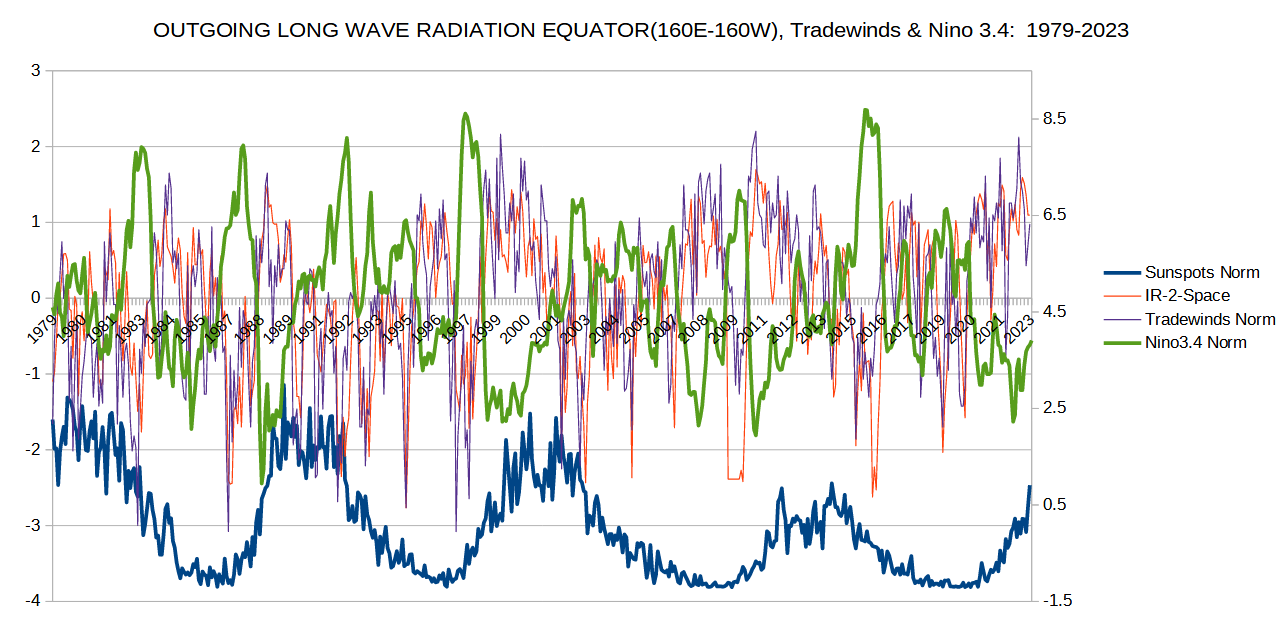 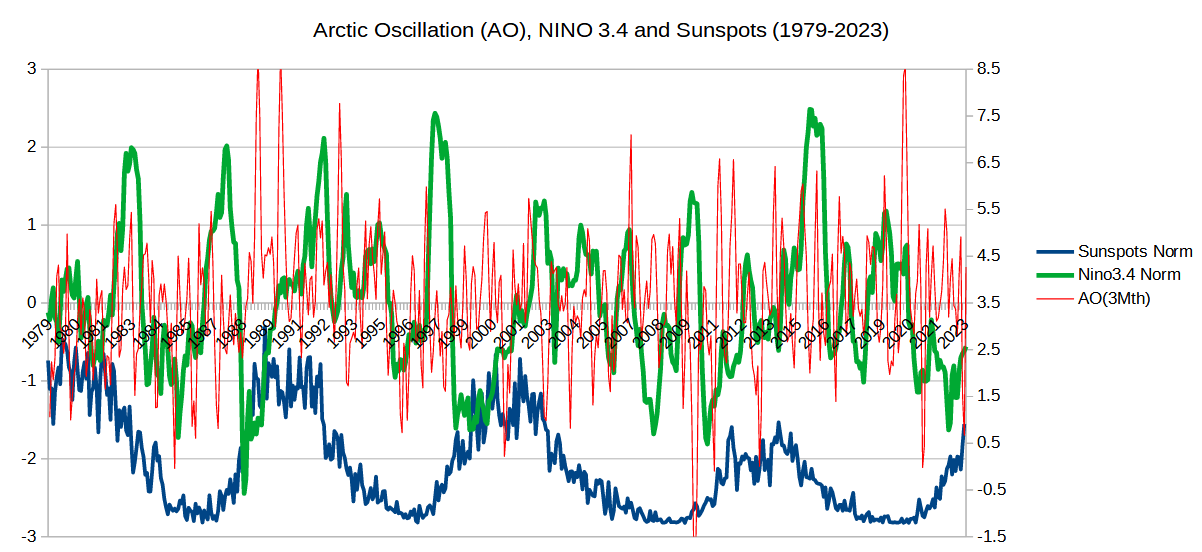 |
|
|
|
Post by missouriboy on Mar 13, 2023 20:51:57 GMT
If this is a gravity wave, it doesn't appear to be progressing past mid-Pacific. It "seems" that some deeper flow, moving upward in the east-mid Pacific is what is surfacing in the East Pacific (Region 1+2 and 3). ?? I don't have immediate access to previous time periods to compare against.
 |
|
|
|
Post by Sigurdur on Mar 14, 2023 1:49:01 GMT
Agree
|
|
|
|
Post by missouriboy on Mar 14, 2023 3:21:17 GMT
I'd suggest there's no one thing that changed trade winds. A quick Google finds some harmony with QBO for example www-das.uwyo.edu/~geerts/cwx/notes/chap11/qbo_enso.htmlI mess around with virtual synths alot, I enjoy using random modulators on, say a bandpass filter. Perhaps using different random wave patterns to modulate resonance and frequency, maybe add a formant filter and use additional random generators etc etc building up a complex generative pattern. The sound is completely random within the parameters I choose. At the extremes, dissonance and distortion create atmospheric and hypnotic sounds which ebb and flow, but they become recognisable within those parameters. Of course I can change the parameters, change from saw wave to sine...add delay etc etc etc. Similarly....I think enso is a function of many radom generators, including the initial condition...here assumed to be the wind. Solar minimums are 9/86, 8/96, 12/08, 12/19 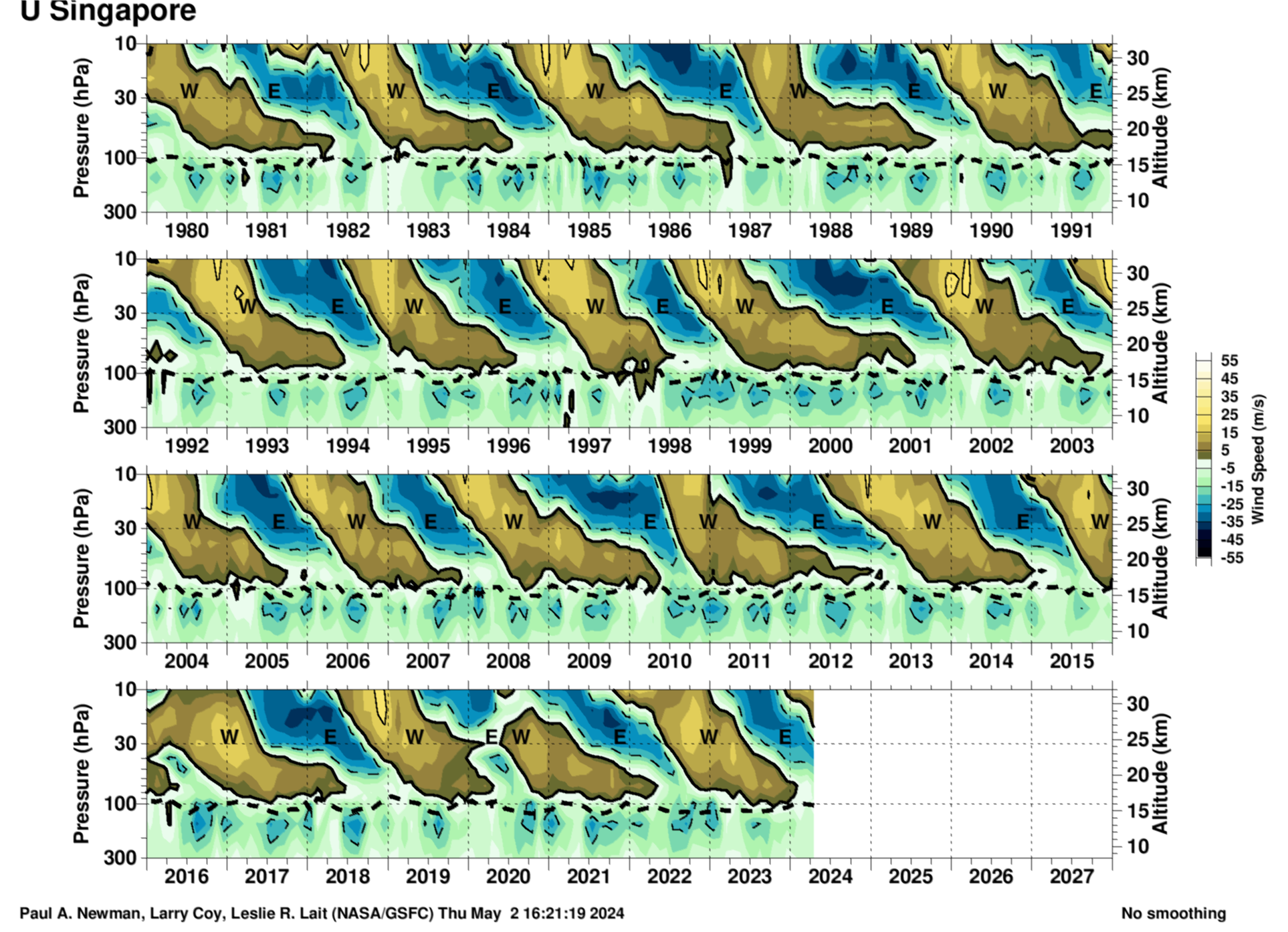 |
|
|
|
Post by nonentropic on Mar 14, 2023 4:23:13 GMT
2020 to 2022 look very different, why??
If any thing the 2019 "boot" is a little truncated 2015 to 2017 is a bit smeared.
Interesting is it not
|
|
|
|
Post by missouriboy on Mar 14, 2023 8:34:36 GMT
2020 to 2022 look very different, why?? If any thing the 2019 "boot" is a little truncated 2015 to 2017 is a bit smeared. Interesting is it not Yes. And the change ... whatever that is ... seems to begin with a weaker solar cycle 24. The reboot that didn't. |
|
|
|
Post by justme on Mar 17, 2023 15:40:22 GMT
|
|
|
|
Post by missouriboy on Mar 17, 2023 19:25:04 GMT
Good one Justme. This is going to take a while to dissect. There was another short article put out at about the start of SC25 (buried in the Solar Cycle 25 thread), which used their interpretation of the terminator event to predict a historically strong SC25. That would appear to have been a bust. Looking forward to seeing what this one offers.
|
|
|
|
Post by ratty on Mar 17, 2023 21:46:48 GMT
Unrelated? I've just spotted the cool anomaly in the South China Sea. 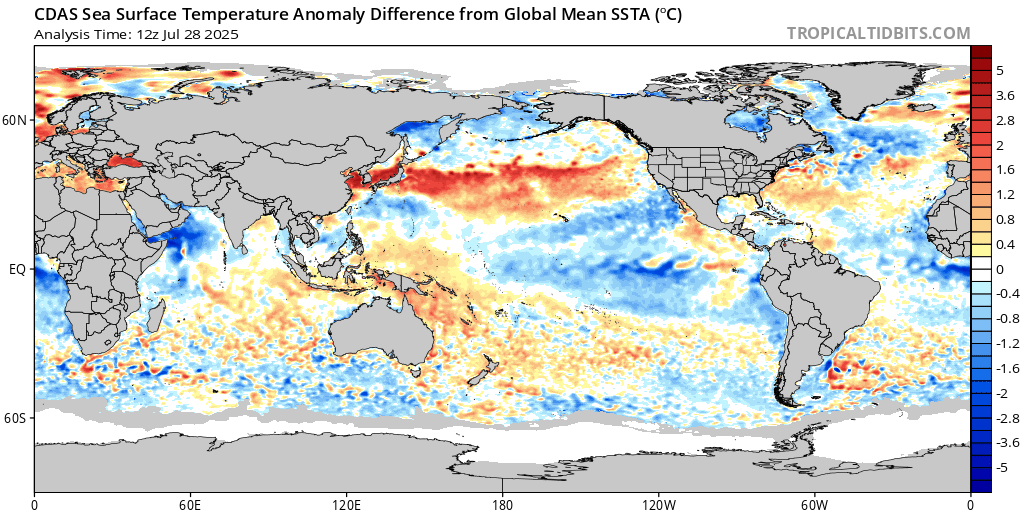 |
|